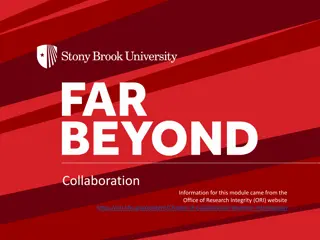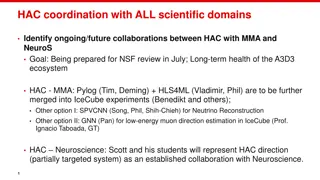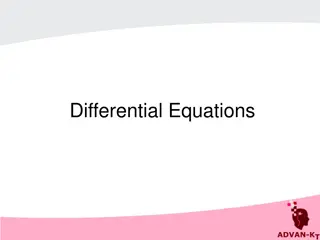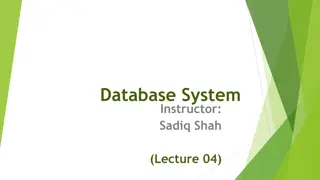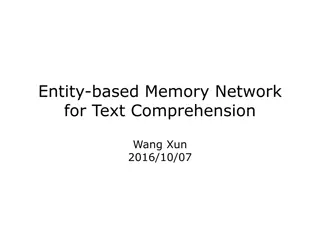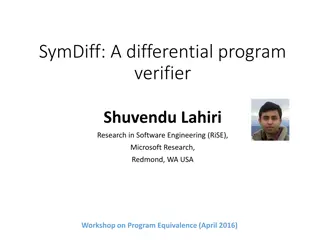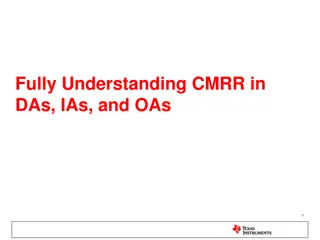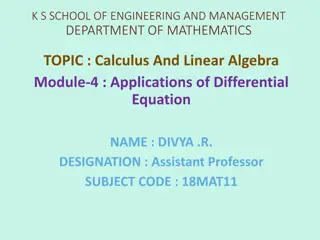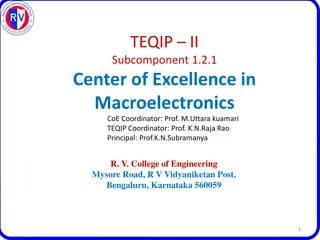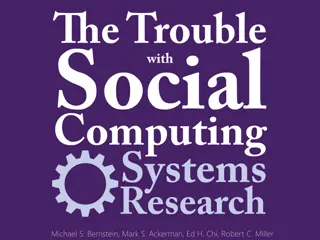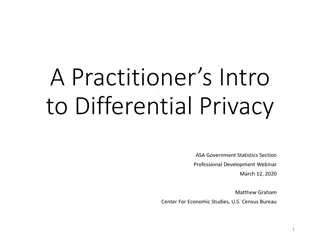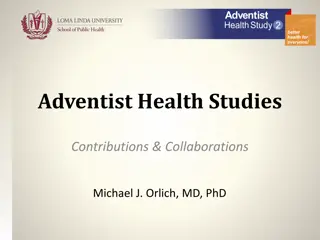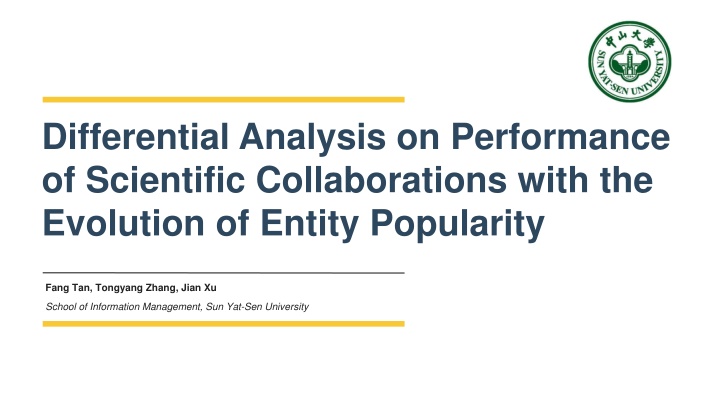
Differential Analysis on Scientific Collaborations and Entity Popularity
Explore the impact of topic popularity on scientific collaborations through the evolution of entity metrics. Analyses focus on the selection of research topics and their effect on collaboration performance, providing insights for decision-making in research topic selection and project management.
Download Presentation

Please find below an Image/Link to download the presentation.
The content on the website is provided AS IS for your information and personal use only. It may not be sold, licensed, or shared on other websites without obtaining consent from the author. If you encounter any issues during the download, it is possible that the publisher has removed the file from their server.
You are allowed to download the files provided on this website for personal or commercial use, subject to the condition that they are used lawfully. All files are the property of their respective owners.
The content on the website is provided AS IS for your information and personal use only. It may not be sold, licensed, or shared on other websites without obtaining consent from the author.
E N D
Presentation Transcript
Differential Analysis on Performance of Scientific Collaborations with the Evolution of Entity Popularity Fang Tan, Tongyang Zhang, Jian Xu School of Information Management, Sun Yat-Sen University
CONTENTS 1 INTRODUCTION METHODOLOGY 2 3 PRELIMINARY RESULTS 4 CONCLUSION AND FUTURE WORK 5 REFERENCES 02 Differential Analysis on Performance of Scientific Collaborations with the Evolution of Entity Popularity
INTRODUCTION Background Identifying promising research topics is a key success factor of the ultimate success of scientific collaborations [1]. The selection of a promising research topic can encourage the process of scientific discovery scientists and promote the development of the whole research field [2]. 03 Differential Analysis on Performance of Scientific Collaborations with the Evolution of Entity Popularity
INTRODUCTION Present Study Focus on the development law that underlie an individual's behavior of selecting topics Few studies explore the impact of topic popularity on scientific performance of scientific collaborations from the perspective of entitymetrics. Differential Analysis on Performance of Scientific Collaborations with the Evolution of Entity Popularity 04
INTRODUCTION Purpose Analyze biomedicine related research from the perspective of entitymetrics. the evolution of topic popularity in Analyze the effect mechanisms of entity popularity on performance of scientific collaborations. Provide decision makers in research topic selection and the management of scientific research project. a theoretical reference for relevant 05 Differential Analysis on Performance of Scientific Collaborations with the Evolution of Entity Popularity
METHODOLOGY Differential Analysis on Performance of Scientific Collaborations with the Evolution of Entity Popularity 06
METHODOLOGY Data acquisition and processing Biomedical data from PubMed between 1988 and 2017 is obtained based on BERT [3] and Bio BERT [4]. Two types of data: Entity Data Author Data 07 Differential Analysis on Performance of Scientific Collaborations with the Evolution of Entity Popularity
METHODOLOGY Stage division of entity popularity Based on the model tree proposed by Ma [5]. The slope k is less than or equal to -0.05 when the entity s descending (short for descending stage ); k is greater than or equal to 0.05 when the entity s popularity stage is ascending (short for ascending stage ). popularity stage is 08 Differential Analysis on Performance of Scientific Collaborations with the Evolution of Entity Popularity
METHODOLOGY Differential analysis on performance of scientific collaborations in various stages of entity popularity. Compare statistics on the number of published periodical articles and citations of teams of each scientific collaboration in descending stages. the ascending and We recognize authors of the same article as a research team. Teams in which the number of authors is less than three or over 10, and groups in which ages of authors are all over 45 are ruled out. As long as the target entities appear in the title of abstract of an article, we consider the team has studied the entities. Differential Analysis on Performance of Scientific Collaborations with the Evolution of Entity Popularity 09
PRELIMINARY RESULTS Yearly Distribution of the Number of Research Teams in the Ascending Stage and Descending Stage After the 21st century, Ascending teams: Has experienced rapid growth. Descending teams: Shows a slightly declining trend 13 Differential Analysis on Performance of Scientific Collaborations with the Evolution of Entity Popularity
Differential Analysis on Performance of Scientific Collaboration Research PRELIMINARY RESULTS Either the overall average normalized citations or the annual average normalized citations of teams in the ascending stage remains significantly higher than that of teams in the descending stage. For research outputs of teams in the ascending stage, the earlier the published year, the more normalized citations compared to teams in the descending stage. Differential Analysis on Performance of Scientific Collaborations with the Evolution of Entity Popularity 14
CONCLUSION AND FUTURE WORK Conclusion The popularity stage that a research topic is going through can play a role in the research performance of scientific collaboration. 1 Compared with the descending stage, the ascending stage puts more positive impacts on collaboration research performance 2 For different scientific collaboration modes, the study can be used as a reference in choosing research topics. 3 Differential Analysis on Performance of Scientific Collaborations with the Evolution of Entity Popularity 19
CONCLUSION AND FUTURE WORK Future work Differences personnel composition of a team will be considered in the study. in other aspects such as 1 How sustentation funding, one of the most important external resources to encourage team research, distributes in the two types of teams? 2 The impact of other factors (e.g. continuity of government funding) popularity. 3 on research Differential Analysis on Performance of Scientific Collaborations with the Evolution of Entity Popularity 20
REFERENCES [1] impactful research topics: A case of three decades of HIV-AIDS research. Journal of Informetrics, 15(1): 101122. DOI: https://doi.org/10.1016/j.joi.2020.101122. [2] Sten Andler. 1979. Predicate path expressions. In Proceedings of the 6th. ACM SIGACT-SIGPLAN Symposium on Principles of Programming Languages (POPL '79). ACM Press, New York, NY, 226-236. DOI: https://doi.org/10.1145/567752.567774. [3] Ian Editor (Ed.). 2007. The title of book one (1st. ed.). The name of the series one, Vol. 9. University of Chicago Press, Chicago. DOI: https://doi.org/10.1007/3-540-09237- 4. [4] David Kosiur. 2001. Understanding Policy-Based Networking (2nd. ed.). Wiley, New York, NY. [5] J. Guan, Y. Yan, J. J. Zhang. 2017. The impact of collaboration and knowledge networks on citations. Journal of Informetrics, 11(2): 407-422. Ran Xu, Arash Baghaei Lakeh and et al. 2020. Examining the characteristics of Differential Analysis on Performance of Scientific Collaborations with the Evolution of Entity Popularity 21
Thank you! Fang Tan, Tongyang Zhang, Jian Xu Email:tzhang39@163.com School of Information Management, Sun Yat-Sen University

